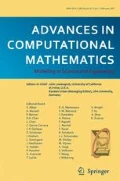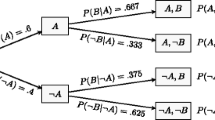Abstract
The LambertW function is defined to be the multivalued inverse of the functionw →we w. It has many applications in pure and applied mathematics, some of which are briefly described here. We present a new discussion of the complex branches ofW, an asymptotic expansion valid for all branches, an efficient numerical procedure for evaluating the function to arbitrary precision, and a method for the symbolic integration of expressions containingW.
Similar content being viewed by others
References
G. Alefeld, On the convergence of Halley's method, Amer. Math. Monthly 88 (1981) 530–536.
American National Standards Institute/Institute of Electrical and Electronic Engineers:IEEE Standard for Binary Floating-Point Arithmetic, ANSI/IEEE Std 754–1985, New York (1985).
J.D. Anderson,Introduction to Flight, 3rd ed. (McGraw-Hill, New York, 1989).
V.I. Arnold,Mathematical Methods for Classical Mechanics (Springer-Verlag, 1978).
I.N. Baker and P.J. Rippon, Convergence of infinite exponentials, Ann. Acad. Sci. Fenn. Ser. AI Math. 8 (1983) 179–186.
I.N. Baker and P.J. Rippon, A note on complex iteration, Amer. Math. Monthly 92 (1985) 501–504.
D.A. Barry, J.-Y. Parlange, G.C. Sander and M. Sivaplan, A class of exact solutions for Richards' equation, J. Hydrology 142 (1993) 29–46.
R.E. Bellman and K.L. Cooke,Differential-Difference Equations (Academic Press, 1963).
W.H. Beyer (ed.),CRC Standard Mathematical Tables, 28th ed. (1987).
C.W. Borchardt, Ueber eine der Interpolation entsprechende Darstellung der Eliminations-Resultante, J. reine angewandte Math. 57 (1860) 111–121.
N.G. de Bruijn,Asymptotic Methods in Analysis (North-Holland, 1961).
C. Carathéodory,Theory of Functions of a Complex Variable (Chelsea, 1954).
A. Cayley, A theorem on trees, Quarterly Journal of Mathematics, Oxford Series 23 (1889) 376–378.
B.W. Char, K.O. Geddes, G.H. Gonnet, B.L. Leong, M.B. Monagan and S.M. Watt,The Maple V Language Reference Manual (Springer-Verlag, 1991).
L. Comtet,Advanced Combinatorics (Reidel, 1974).
S.D. Conte and C. de Boor,Elementary Numerical Analysis, 3rd ed. (McGraw-Hill, 1980).
D. Coppersmith, private communication.
R.M. Corless, What good are numerical simulations of chaotic dynamical systems?, Computers Math. Applic. 28 (1994) 107–121.
R.M. Corless,Essential Maple (Springer-Verlag, 1994).
R.M. Corless and D.J. Jeffrey, Well, It Isn't Quite That Simple, SIGSAM Bulletin 26 (3) (1992) 2–6.
R.M. Corless, G.H. Gonnet, D.E.G. Hare, and D.J. Jeffrey, Lambert'sW function in Maple, The Maple Technical Newsletter 9 (1993) 12–22.
H.T. Davis,Introduction to Nonlinear Differential and Integral Equations (Dover, 1962).
L. Devroye, A note on the height of binary search trees, J. ACM 33 (1986) 489–498.
O. Dziobek, Eine Formel der Substitutionstheorie, Sitzungsberichte der Berliner Mathematischen Gesellschaft 17 (1917) 64–67.
G. Eisenstein, Entwicklung von αα, J. reine angewandte Math. 28 (1844) 49–52.
P. Erdös and A. Rényi, On the evolution of random graphs, Magyar Tud. Akad. Mat. Kut. Int. Közl. 5 (1960) 17–61. Reprinted in P. Erdös,The Art of Counting (1973) pp. 574–618, and inSelected Papers of Alfréd Rényi (1976), pp. 482–525.
L. Euler, De formulis exponentialibus replicatis, Leonhardi Euleri Opera Omnia, Ser. 1, Opera Mathematica 15 (1927) [original date 1777] 268–297.
L. Euler, De serie Lambertina plurimisque eius insignibus proprietatibus, Leonhardi Euleri Opera Omnia, Ser. 1, Opera Mathematica 6 (1921) [orig. date 1779] 350–369.
P. Flajolet and M. Soria, Gaussian Limiting Distributions for the Number of Components in Combinatorial Structures, J. Combinatorial Theory, Series A 53 (1990) 165–182.
F.N. Fritsch, R.E. Shafer, and W.P. Crowley, Algorithm 443: Solution of the transcendental equationwe w=x, Comm. ACM 16 (1973) 123–124.
K.O. Geddes, S.R. Czapor and G. Labahn,Algorithms for Computer Algebra (Kluwer Academic Publishers, 1992).
Ch.C. Gillispie (ed.),Dictionary of Scientific Biography (Scribners, N.Y., 1973).
G.H. Gonnet,Handbook of Algorithms and Data Structures (Addison-Wesley, 1984).
G.H. Gonnet, Expected length of the longest probe sequence in hash code searching, J. ACM 28 (1981) 289–304.
R.L. Graham, D.E. Knuth and O. Patashnik,Concrete Mathematics (Addison-Wesley, 1994).
N.D. Hayes, Roots of the transcendental equation associated with a certain difference-differential equation, J. Lond. Math. Soc. 25 (1950) 226–232.
N.D. Hayes, The roots of the equationx=(c exp)n x and the cycles of the substitution (x|ce x), Q. J. Math. 2 (1952) 81–90.
T.L. Heath,A Manual of Greek Mathematics (Dover, 1963).
E.W. Hobson,Squaring the Circle (Chelsea, 1953).
T.E. Hull, W.H. Enright, B.M. Fellen and A.E. Sedgwick, Comparing numerical methods for ordinary differential equations, SIAM J. Numer. Anal. 9 (1972) 603–637.
S. Janson, D.E. Knuth, T. Łuczak and B. Pittel, The birth of the giant component,Random Structures and Algorithms 4 (1993) 233–358.
D.J. Jeffrey, R.M. Corless, D.E.G. Hare and D.E. Knuth, Sur l'inversion dey a e y e y au moyen de nombres de Stirling associés, C. R. Acad. Sc. Paris, Série I, 320, 1449–1452.
D.J. Jeffrey, R.M. Corless and D.E.G. Hare, Unwinding the branches of the LambertW function, The Mathematical Scientist, 21, 1–7.
W. Kahan, Branch cuts for complex elementary functions, InThe State of the Art in Numerical Analysis: Proc. Joint IMA/SIAM Conf. on the State of the Art in Numerical Analysis, University of Birmingham, April 14–18, 1986, eds. M.J.D. Powell and A. Iserles (Oxford University Press, 1986).
J. Karamata, Sur quelques problèmes posés par Ramanujan, J. Indian Math. Soc. 24 (1960) 343–365.
R.A. Knoebel, Exponentials reiterated, Amer. Math. Monthly 88 (1981) 235–252.
D.E. Knuth and B. Pittel, A recurrence related to trees, Proc. Amer. Math. Soc. 105 (1989) 335–349.
J.H. Lambert, Observationes variae in mathesin puram, Acta Helvetica, physico-mathematico-anatomico-botanico-medica 3, Basel (1758) 128–168.
J.H. Lambert, Observations Analytiques, inNouveaux mémoires de l'Académie royale des sciences et belles-lettres, Berlin (1772) vol. 1, for 1770.
H.G. Landau, On some problems of random nets, Bull. Mathematical Biophysics 14 (1952) 203–212.
E.M. Lémeray, Sur les raciens de l'equationx=a x, Nouvelles Annales de Mathématiques (3) 15 (1896) 548–556.
E.M. Lémeray, Sur les racines de l'equationx=a x. Racines imaginaires, Nouvelles Annales de Mathématiques (3) 16 (1897) 54–61.
E.M. Lémeray, Racines de quelques équations transcendantes. Intégration d'une équation aux différences mèlées. Racines imaginaires, Nouvelles Annales de Mathématiques (3) 16 (1897) 540–546.
R.E. O'Malley, Jr.,Singular Perturbation Methods for Ordinary Differential Equations (Springer-Verlag Applied Mathematical Sciences 89, 1991).
F.D. Parker, Integrals of inverse functions, Amer. Math. Monthly 62 (1955) 439–440.
G. Pólya and G. Szegö,Problems and Theorems in Analysis (Springer-Verlag, 1972).
G. Pólya, Kombinatorische Anzahlbestimmungen für Gruppen, Graphen und chemische Verbindungen, Acta Mathematica 68 (1937) 145–254. English translation by Dorothee Aeppli in G. Pólya and R.C. Read,Combinatorial Enumeration of Groups, Graphs, and Chemical Compounds (Springer-Verlag, 1987).
K.B. Ranger, A complex variable integration technique for the two-dimensional Navier-Stokes equations, Q. Applied Math. 49 (1991) 555–562.
E.L. Reiss, A new asymptotic method for jump phenomena, SIAM J. Appl. Math. 39 (1980) 440–455.
J.M. Robson, The height of binary search trees, Aust. Comput. J. 11 (1979) 151–153.
L.A. Segel and M. Slemrod, The quasi-steady-state assumption: a case study in perturbation, SIAM Review 31 (1989) 446–477.
T.C. Scott, J.F. Babb, A. Dalgarno and J.D. Morgan III, Resolution of a paradox in the calculation of exchange forces forH +2 , Chem. Phys. Lett. 203 (1993) 175–183.
T.C. Scott, J.F. Babb, A. Dalgarno and J.D. Morgan III, The calculation of exchange forces: general results and specific models, J. Chem. Phys. 99 (1993) 2841–2854.
O. Skovgaard, I.G. Jonsson, and J.A. Bertelsen, Computation of wave heights due to refraction and friction, J. Waterways Harbours and Coastal Engineering Division, February, 1975, pp. 15–32.
R. Solomonoff and A. Rapoport, Connectivity of random nets, Bull. Math. Biophysics 13 (1951) 107–117.
D.C. Sorensen and Ping Tak Peter Tang, On the orthogonality of eigenvectors computed by divide-and-conquer techniques, SIAM J. Numer. Anal. 28 no. 6 (December 1991) 1752–1775.
J.J. Sylvester, On the change of systems of independent variables, Q. J. Pure and Applied Math. 1 (1857) 42–56.
E.C. Titchmarsh,Theory of Functions, 2nd ed. (Oxford, 1939).
E.M. Wright, The linear difference-differential equation with constant coefficients, Proc. Royal Soc. Edinburgh, A 62 (1949) 387–393.
E.M. Wright, A non-linear difference-differential equation, J. für reine und angewandte Mathematik 194 (1955) 66–87.
E.M. Wright, Solution of the equationze z=a, Proc. Roy. Soc. Edinburgh A 65 (1959) 193–203.
E.M. Wright, The number of connected sparsely edged graphs, J. Graph Theory 1 (1977) 317–330.
Author information
Authors and Affiliations
Additional information
Communicated by W.H. Enright
Rights and permissions
About this article
Cite this article
Corless, R.M., Gonnet, G.H., Hare, D.E.G. et al. On the LambertW function. Adv Comput Math 5, 329–359 (1996). https://doi.org/10.1007/BF02124750
Received:
Revised:
Issue Date:
DOI: https://doi.org/10.1007/BF02124750




